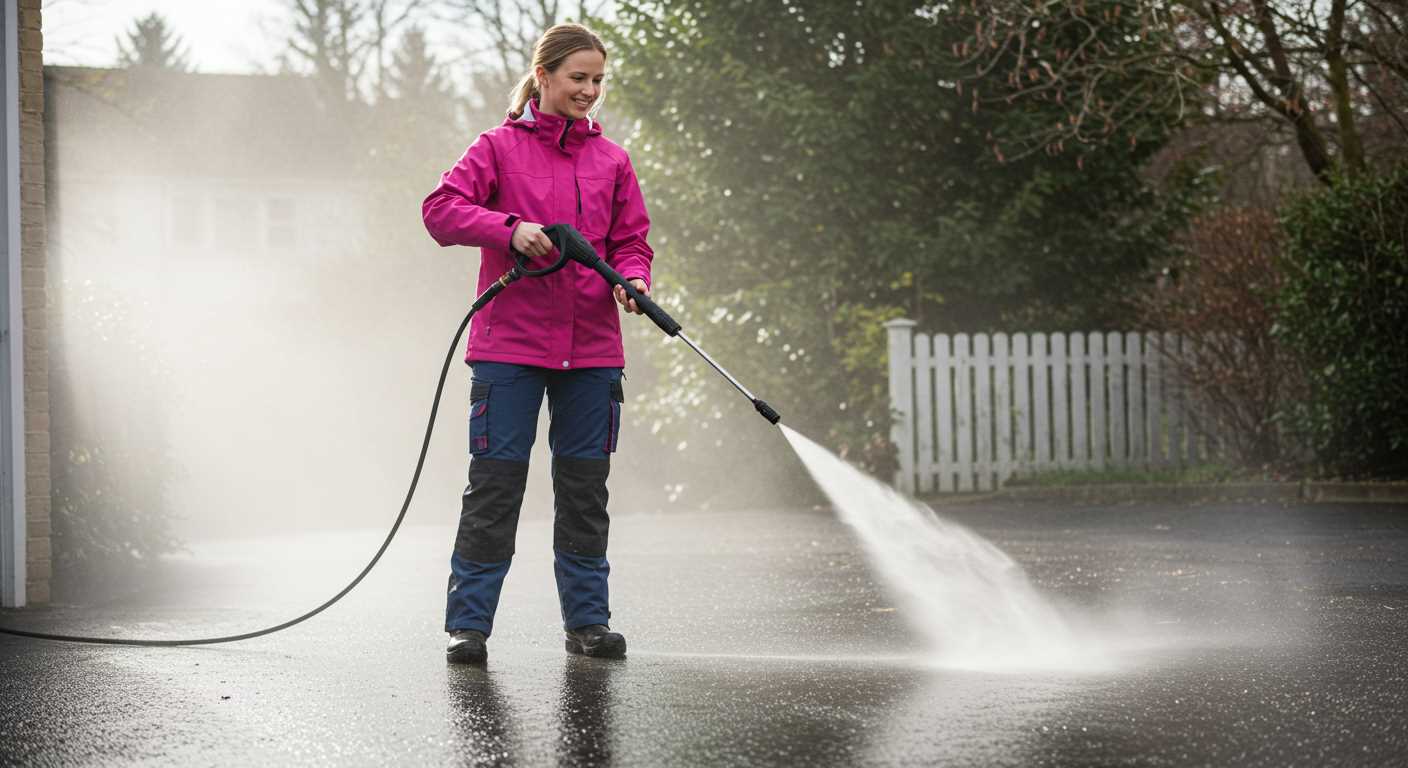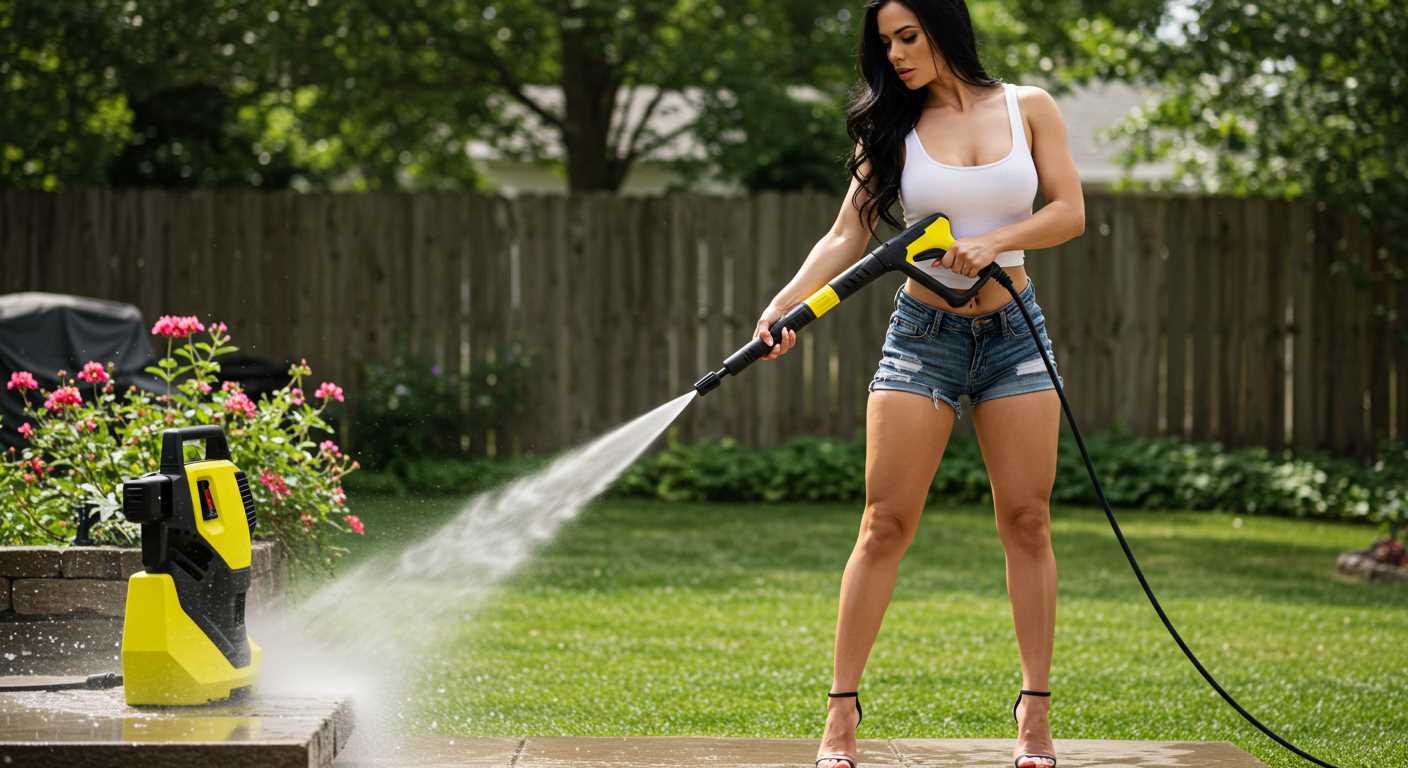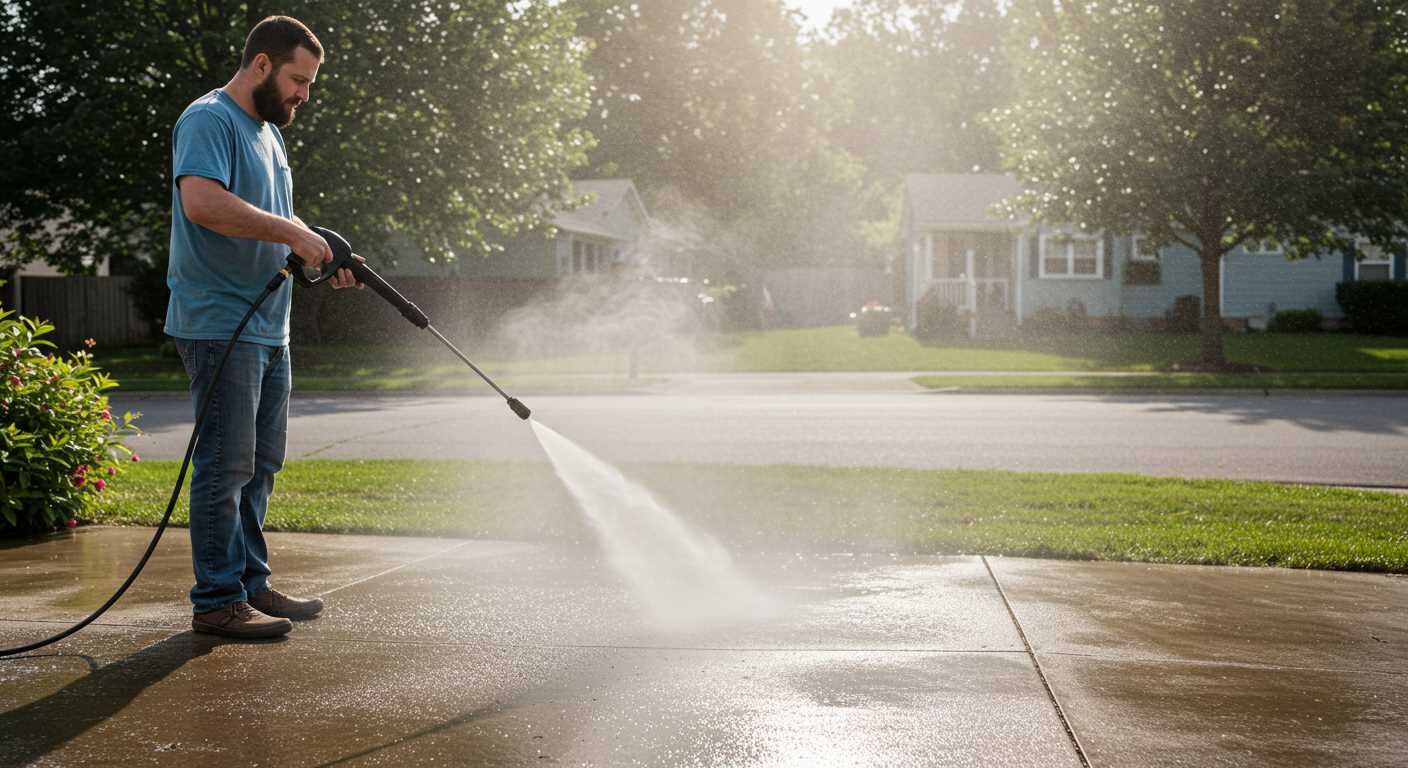




Consider a large container or a rainwater barrel as your primary source. I’ve often relied on these methods during outdoor projects, especially when traditional plumbing isn’t available. A simple gravity feed can work wonders; just ensure the intake hose is submerged properly to prevent air from entering the system. You’d be surprised how well a 100-litre tank can power through grime.
Another option I found effective is a portable water pump. I once had a job where I needed to clean a patio, and the nearest tap was over 50 metres away. I connected a pump to a nearby water source, allowing me to draw water efficiently. It’s crucial to choose a pump capable of maintaining the necessary pressure; otherwise, the results will be disappointing. Always check the specifications before making a purchase.
Lastly, consider using a water recycling system. During one of my projects, I fashioned a setup that collected runoff water. This not only saved on fresh water but also proved to be an eco-friendly solution. Establish a collection system that directs water back into your tank to reduce waste while keeping your cleaning tasks on track.
Understanding Types Suitable for Dry Use
For applications where traditional liquid sources are absent, selecting the right equipment becomes paramount. I’ve encountered several models that adapt well to such scenarios, and here’s what I’ve learned over the years.
Types of Machines
- Electric Models – These are generally lightweight and portable. They often come with adjustable pressure settings, making them versatile for various tasks. Look for models with a built-in tank for detergent, which can be beneficial for certain cleaning tasks without needing a continuous flow of liquid.
- Battery-Operated Units – Ideal for mobility, these machines are perfect for remote locations. They offer decent pressure and can handle light to moderate cleaning jobs. Ensure the battery life meets your requirements to avoid interruptions.
- Dry Ice Blasters – A unique option that uses dry ice pellets to lift grime without moisture. This method is particularly effective for delicate surfaces and industrial applications, where water could cause damage.
Key Features to Consider
- Pressure Adjustment – Look for equipment that allows you to modify the output force, ensuring you can handle various surfaces effectively.
- Portability – Compact designs with wheels or handles make transport easier, especially in areas lacking infrastructure.
- Compatibility with Accessories – Some models offer attachments for specific tasks, enhancing their functionality even in dry conditions.
In my experience, always check for user reviews and product specifications. Each type has its strengths and weaknesses, and understanding these nuances will lead to better choices tailored to your needs.
Preparing a Water Source Alternative for Your Pressure Washer
Collecting rainwater is one of the simplest methods to create an alternative source for your cleaning equipment. Set up a rain barrel or a large container under your downspouts. Ensure the container is clean and free from debris to avoid clogging your tools. I once transformed an old plastic barrel into a rain collector, which proved invaluable during summer droughts. The water was always available for my cleaning tasks, and it felt good to make use of nature’s resources.
Utilising Buckets and Tanks
If rainwater harvesting isn’t feasible, consider using buckets or tanks. Fill them with water from a nearby source, like a hose or tap, then connect your equipment to the tank. I recall an instance where I filled several buckets for a weekend project. It was a bit of a workout, but the satisfaction of completing the task was worth it. Ensure the tank has a sturdy lid to prevent contamination.
Portable Water Containers
For those on the go, portable water containers are a fantastic option. These can be easily transported, making them perfect for outdoor projects. I’ve often taken a 5-gallon jug along with me to construction sites. Simply place it next to your equipment, and you’re ready to clean. Just remember to check the fittings to guarantee a tight seal to maintain pressure.
As a bonus, consider exploring creative uses for your collected water. You might even incorporate it into garden maintenance or other household tasks. For more tips on tools and their compatibility with various activities, check out a digital cameras resolution quiz for insights that could enhance your overall experience.
Connecting a pressure cleaner to a water tank
To link a high-performance cleaner to a water tank, ensure you have the right hose and fittings. A standard garden hose typically suffices, but if the tank is far away, consider a reinforced hose to prevent kinks and ensure optimal flow.
Choosing the right fittings
Adapters may be necessary to connect your hose to the tank outlet. Select fittings that match the hose diameter for a secure connection. A quick-release coupling can simplify the attachment and detachment process, saving time when switching between tasks.
Maintaining water flow
To achieve consistent flow, position the tank at a height that allows gravity to assist the water movement. If the tank is on the ground, a submersible pump can help draw water effectively. Always check for leaks in the connections to avoid any interruptions during operation.
Using a Water Pump with Your Pressure Washer
For those situations where a direct connection to a plumbing system isn’t viable, integrating a pump can be a game changer. My experience has shown that selecting the right pump significantly enhances versatility and performance.
Here’s what I recommend based on direct encounters:
- Pump Type: Opt for a diaphragm or submersible pump. Diaphragm pumps are excellent for drawing water from a tank, while submersible pumps are ideal if you’re working with deep containers.
- Flow Rate: Ensure the pump’s flow rate matches the requirements of your equipment. A lower flow rate can lead to insufficient pressure and reduced cleaning capability.
- Pressure Compatibility: Choose a pump that can handle similar pressure levels as your unit. This prevents damage to either component and ensures optimal operation.
During one project, I encountered a stubborn oil stain on a concrete driveway. A submersible pump connected to a large tank worked wonders, providing a consistent flow. I was able to maintain the necessary pressure throughout the task, resulting in a spotless surface.
Installation is straightforward:
- Position the pump near your water source, ensuring easy access to the tank or reservoir.
- Connect a hose from the pump outlet to the inlet of your high-pressure unit.
- Attach the power source to the pump, ensuring it’s in a dry location to prevent any electrical hazards.
Always check for leaks after making connections. A small leak can lead to significant issues, especially if the pump is not primed correctly. I’ve learned this the hard way–losing valuable time and effort to fix preventable problems.
Regular maintenance of the pump is crucial. Clean the filters and check for any wear and tear periodically. This ensures longevity and reliable performance during your tasks.
In scenarios where access to pressurised plumbing is limited, a well-chosen pump can be your best ally. My experiences have shown that with the right setup, even the toughest cleaning jobs can be tackled efficiently.
Choosing the Right Nozzle for Optimal Cleaning
Selecting the appropriate nozzle is key to maximising the performance of your equipment. Each nozzle type serves a unique purpose and can significantly influence the cleaning outcome.
- Zero-Degree Nozzle: This nozzle produces a concentrated jet, ideal for targeted cleaning of tough stains such as oil or rust. However, use with caution, as it can damage delicate surfaces.
- 15-Degree Nozzle: A versatile choice for removing grime from hard surfaces like concrete or brick. It strikes a balance between power and coverage, making it suitable for various applications.
- 25-Degree Nozzle: Excellent for general cleaning tasks, including vehicles and patios. It offers a wider spray pattern, ensuring thorough coverage without being overly aggressive.
- 40-Degree Nozzle: Perfect for softer surfaces such as wood or painted materials. The gentle spray minimises the risk of damage, making it ideal for delicate projects.
- Soap Nozzle: This nozzle is specifically designed for applying detergents. Typically, it has a wider spray pattern and lower pressure, allowing for even distribution of cleaning agents.
From my experience, always consider the surface material and the type of dirt or stain before choosing a nozzle. For instance, when cleaning old wooden decks, I often reach for the 40-degree nozzle to avoid gouging the wood. On the other hand, when tackling oil spills in the garage, the zero-degree nozzle provides the power needed to lift stubborn stains.
Additionally, experimenting with different nozzles can lead to surprising results. I once used a 15-degree nozzle on a brick patio and was amazed at how effectively it removed years of grime. Remember to adjust your technique based on the nozzle selected, as the distance from the surface and angle of approach can alter the effectiveness of your cleaning.
In conclusion, the right nozzle can transform your cleaning experience. Keep a variety of nozzles on hand to ensure you’re prepared for any task, and don’t hesitate to switch them out as needed for optimal results.
Adjusting Pressure Settings for Different Surfaces
For optimal cleaning results, tailoring the force of the stream to the material you’re working on is vital. Soft surfaces, like wood decks, require a gentler approach–typically around 1200 to 1500 PSI. I recall restoring my own deck; a lower setting ensured I didn’t damage the wood while effectively removing grime. Using a deck cleaner to use with pressure washer amplified the results without risking splintering.
Hard Surfaces
Conversely, hard surfaces such as concrete or brick can handle higher pressures–ranging from 2500 to 3000 PSI. During a recent project cleaning my driveway, I cranked up the pressure and swiftly tackled stubborn stains. A rotating nozzle worked wonders here, allowing me to cover more area effectively while maintaining a safe distance from the surface.
Delicate Surfaces
For delicate surfaces like cars or windows, it’s wise to operate at a lower setting, ideally below 2000 PSI. I once made the mistake of using too high a pressure on my car–causing minor scratches. Now, I keep a close eye on the settings and opt for a fan nozzle for a wider spray, which reduces the risk of damage. Adjusting accordingly is key to preserving both the surface and the integrity of the equipment.
Maintaining Your Cleaning Equipment When Using Alternative Water Sources
Regular maintenance is critical, especially when relying on non-traditional sources for liquid. I’ve seen the consequences of neglect firsthand. After a day of using a tank or barrel, it’s essential to flush the system with clean liquid to prevent debris build-up. This simple step can prolong the lifespan of your equipment significantly.
Routine Checks
Inspect the inlet filter frequently. It can easily get clogged with sediment from a tank. Clean it after each session; just a few minutes can save you from costly repairs later. Additionally, check hoses for kinks or leaks. Any damage can lead to reduced performance.
Storing Your Equipment
After a session, if you’ve been using a barrel, ensure that the machine is stored in a dry area. Moisture can promote rust and mildew, especially in internal components. Use a protective cover to shield it from dust and debris, ensuring it’s ready for the next task. Proper storage extends the life of seals and gaskets, which can wear out faster when exposed to the elements.
| Maintenance Task | Frequency | Notes |
|---|---|---|
| Clean inlet filter | After each use | Prevents clogging |
| Inspect hoses | Weekly | Look for kinks or wear |
| Flush system | After each use | Removes debris |
| Store properly | After each session | Use a cover |
Taking these steps not only ensures reliability but also maximises the efficiency of your cleaning tool, making every job easier and more effective. From my experience, those who take the time to maintain their gear consistently are rewarded with outstanding performance and longevity.
Safety Precautions When Operating Without Direct Water Supply
Always ensure that the alternative water source is clean and free from debris. Contaminants can damage the internal components of your machine. I once encountered a situation where I used a tank with sediment at the bottom. It clogged the inlet filter, leading to overheating and costly repairs.
Check the manufacturer’s instructions regarding the minimum level of water required for operation. Insufficient fluid can lead to pump damage. I recall a friend who underestimated this and ended up with a burnt-out motor after just a few minutes of operation.
Monitoring Pressure Levels
Regularly monitor the pressure levels to prevent excessive strain on the equipment. If it starts to pulse or fluctuate, it could indicate insufficient flow. I learned this the hard way during a project where I ignored the signs, resulting in a failure that halted the entire job.
Protective Gear
Wear appropriate personal protective equipment (PPE), such as goggles, gloves, and non-slip footwear. High-velocity jets can cause serious injury. I always make it a point to have my safety gear on before starting, especially during outdoor tasks where surfaces can be slippery.
Common troubleshooting tips for pressure washers without water supply
One of the most frequent issues I’ve encountered with these machines is air getting trapped in the system. Before starting, ensure that all hoses are securely connected and free of leaks. If you notice reduced performance, try bleeding the system by disengaging the trigger and allowing the unit to run until water flows steadily.
Monitoring performance
It’s crucial to keep an eye on the flow rate. If it drops unexpectedly, check the inlet filter for blockages. Cleaning this filter regularly can prevent many related problems. I’ve had instances where a simple clean-up resolved a significant drop in efficiency.
Identifying unusual noises
Listen for any strange sounds while operating the equipment. A grinding noise might indicate an issue with the pump, while a high-pitched whine could suggest a lack of lubrication. Regular maintenance is key; I always ensure that seals and o-rings are in good condition to avoid unnecessary wear and tear.
| Issue | Possible Cause | Solution |
|---|---|---|
| Reduced flow | Blocked inlet filter | Clean or replace the filter |
| Strange noises | Worn pump components | Inspect and replace worn parts |
| Loss of pressure | Air in the system | Bleed the system |
| Overheating | Insufficient water supply | Ensure water source is adequate |
Another common problem is overheating. Ensure that you’re not exceeding the recommended operating time without allowing for cool-down periods. I’ve learned the hard way that pushing these machines too far can lead to costly repairs.
In my experience, always have a backup plan for water sources. I once relied solely on a rain barrel, which ran dry midway through a job. It’s wise to keep a secondary reservoir on hand, especially when working in remote areas.







.jpg)


